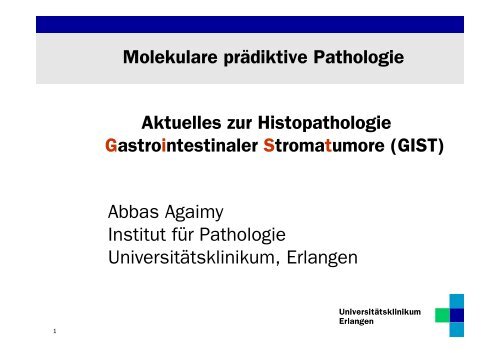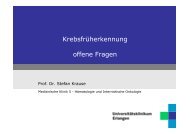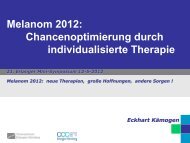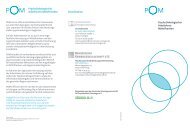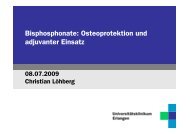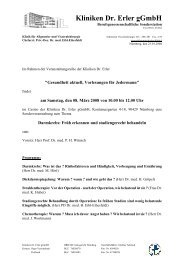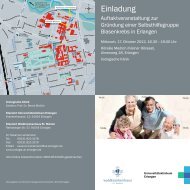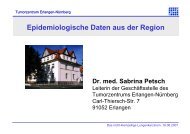(GIST) PD Dr. med. Abbas Agaimy - Tumorzentrum ...
(GIST) PD Dr. med. Abbas Agaimy - Tumorzentrum ...
(GIST) PD Dr. med. Abbas Agaimy - Tumorzentrum ...
Sie wollen auch ein ePaper? Erhöhen Sie die Reichweite Ihrer Titel.
YUMPU macht aus Druck-PDFs automatisch weboptimierte ePaper, die Google liebt.
Molekulare prädiktive Pathologie<br />
Aktuelles zur Histopathologie<br />
Gastrointestinaler Stromatumore (<strong>GIST</strong>)<br />
<strong>Abbas</strong> <strong>Agaimy</strong><br />
Institut für Pathologie<br />
Universitätsklinikum, Erlangen<br />
1
Aktuelle Definition der <strong>GIST</strong><br />
<br />
Primäre spindelzellige/epitheloidzellige mesenchymale Neoplasien<br />
des GI-Traktes mit charakteristischer Histologie und Markerprofil<br />
c-KIT-Mutationen: ≈ 80%<br />
<strong>PD</strong>GFRA-Mutationen: ≈ 10%<br />
Keine Mutation (Wild-typ) ≈ 10%<br />
2
“<strong>GIST</strong> zeigen eine den Cajal-Zellen-ähnliche<br />
Differenzierungslinie”<br />
Cajalzellen (Schrittmacherzellen)<br />
<br />
<br />
in der M. propria<br />
um den Plexus von Auerbach<br />
Morphologie der Cajalzellen:<br />
spindelzellig, CD117+/CD34+<br />
Interstitielle Cajal-Zellen (CD117)<br />
3
<strong>GIST</strong>: Inzidenz und Lokalisation<br />
Inzidenz:<br />
14 bis 20 pro 1.000.000 pro Jahr<br />
Alter: 55–65 J.<br />
Geschlechtsverteilung: M ≥ W<br />
Lokalisation: Magen 60-70%<br />
Duodenum 6%<br />
Dünndarm 20-30%<br />
Kolorektum < 10%<br />
Oesophagus < 1%<br />
Appendix ≤ 1%<br />
4
Endoskopie und EUS: ist eine präoperative<br />
Biopsie sinvoll?<br />
EUS = Endoskopischer Ultraschall<br />
Mit freundlicher Genehmigung von <strong>Dr</strong>. R. DeMatteo<br />
5
Konventionelle endoskopische Biopsie<br />
Bisher gibt es kein Konsensus über Notwendigkeit präoperativer<br />
Biopsie und die Biopsiemethode der Wahl<br />
6
Konventionelle endoskopische Biopsie<br />
Die endoskopische Biopsie häufig unergiebig:<br />
Alle <strong>GIST</strong> entstehen primär in der M. Propria.<br />
Die Submukosa nur selten infiltriert.<br />
Biopsien aus submuköser Raumforderung im Fundus<br />
7
Prä-operative endoskopische Biopsie<br />
(Klinikum Nürnberg)<br />
54/133 <strong>GIST</strong> des oberen GI-Traktes wurden<br />
prä-operativ endoskopisch biopsiert (41%)<br />
(1-4 Biopsieversuche)<br />
Lokalisation<br />
Positive Biopsie<br />
Gesamt = 30%<br />
Antrum-<strong>GIST</strong> = 57%<br />
Duodenum-<strong>GIST</strong> = 44%<br />
Magenkorpus/Fundus = 16%<br />
8
R0 R0 R2<br />
Die endoskopische Abtragung<br />
spielt eine eingeschränkte Rolle<br />
Diagnostisch-therapeutische<br />
Exzision = die Regel bei<br />
lokalisiertem Tumor<br />
9
Makroskopie<br />
Polypoid<br />
Extramural/peritoneal<br />
10<br />
Dumbbell<br />
Pseudozystsich
Morphologie<br />
Spindelzellig 70%<br />
Oft KIT-mutiert<br />
CD117<br />
Epitheloid 20%<br />
Oft <strong>PD</strong>GFRAmutiert<br />
11<br />
CD117
Ausbreitungsmuster<br />
Peritoneale Aussaat<br />
Lebermetastasen Prä-Imatinib<br />
12<br />
Unter Imatinib<br />
Th 11 (selten)
LK-Metastasen beim <strong>GIST</strong><br />
<br />
<br />
Allgemein selten beim regulären <strong>GIST</strong> des Erwachsenenalters<br />
(≈ 1-2%)<br />
Jedoch deutlich erhöht (≥ 20%) bei:<br />
• Alter ≤ 40 Jahre<br />
• +Epitheloider Morphologie<br />
• +Antrum-Lokalisation<br />
• +/-Luminalem Wachstum<br />
• +/-Wild-typ<br />
• +/-Carney-triad (<strong>GIST</strong>+Paragangliom+Lungenchondrom)<br />
13<br />
<strong>Agaimy</strong> & Wünsch, Langenbecks Archiv Surg 2009;394:375-381
<strong>GIST</strong>: Dignitätseinschätzung<br />
1.0<br />
1.0<br />
≤5 mitoses/50 HPF<br />
Recurrence-free<br />
survival<br />
0.75<br />
0.50<br />
0.25<br />
0<br />
P=0.03<br />
10 cm<br />
0 20 40 60 80<br />
Months<br />
Recurrence-free<br />
survival<br />
0.75<br />
0.50<br />
0.25<br />
0<br />
0<br />
P=0.0001<br />
>5 to ≤25 mitoses/50 HPF<br />
>25 mitoses/50 HPF<br />
20 40 60 80<br />
Months<br />
HPF = High Power Fields<br />
Modified from Singer et al. J Clin Oncol. 2002;20:3898.<br />
14
Dignitätseinschätzung<br />
Risiko-Einschätzung der <strong>GIST</strong> nach NIH-Kriterien (Fletcher et al, 2002)<br />
Tumorgrösse<br />
Mitosezahl<br />
Sehr niedriges Risiko < 2 cm < 5/50 HPF<br />
Niedriges Risiko 2-5 cm < 5/50 HPF<br />
Inter<strong>med</strong>iäres Risiko < 5 cm 6-10/50 HPF<br />
5-10 cm < 5/50 HPF<br />
Hochrisiko > 5 cm > 5/50 HPF<br />
> 10 cm jede Mitoserate<br />
jede Größe >10/50 HPF<br />
15
Gesamtüberleben nach Risikogruppen<br />
% Überlebende<br />
1.0<br />
0.9<br />
0.8<br />
0.7<br />
0.6<br />
0.5<br />
0.4<br />
0.3<br />
0.2<br />
0.1<br />
0<br />
Risk Groups<br />
Normal pop.<br />
Very low<br />
Low<br />
Inter<strong>med</strong>iate<br />
High<br />
Overtly malignant<br />
0 1 2 3 4 5 6 7 8 9 10 11 12 13 14 15 16 17<br />
Jahre seit Diagnosestellung<br />
16<br />
Kindblom. Auf http://www.asco.org
Prognostische Einteilung nach Miettinen<br />
Risk assessment categories of gastrointestinal stromal tumours based on size, mitotic<br />
index and<br />
anatomical location<br />
Mitoses<br />
Group Size(cm) HPF Risk category<br />
1 < 2 < 5/50 Stomach:benige<br />
Small intestine: benigne<br />
2 2-5 < 5/50 Stomach: very low malignant potential<br />
Small intestine: low malignant potential<br />
3a 5-10 < 5/50 Stomach: very low malignant potential<br />
Small intestine: malignant potential<br />
3b > 10 < 5/50 Stomach: low-moderate malignant potential<br />
Small intestine: malignant potential<br />
4 < 2 > 5/50 Stomach: uncertain<br />
Small intestine: malignant potential<br />
5 2-5 > 5/50 Stomach: low-moderate malignant potential<br />
Small intestine: malignant potential<br />
6a > 5 > 5/50 Stomach: malignant potential<br />
6b > 10 > 5/50 Small intestine: malignant potential<br />
17<br />
HPF, high power field.<br />
Data from Miettinen et al.<br />
Benigne: no tumour-related mortality detected; very low malignant<br />
potential:
Viele offene Fragen<br />
Warum können manche Low-risk-<strong>GIST</strong> metastasieren?<br />
Dagegen aber manche große <strong>GIST</strong> nicht?<br />
<br />
Weshalb gibt es nur eine Risikostratifizierung und keine<br />
„benigne vs maligne“ Diagnosen?<br />
18
<strong>GIST</strong> bilden ein morphologisch-biologisch-genetisches Kontinuum,<br />
auch innerhalb desselben Tumors (= intratumorale Heterogenität)<br />
individualisierte Risikobestimmung notwendig?<br />
Very low risk<br />
low risk<br />
19<br />
Inter<strong>med</strong>iate risk<br />
High risk
Morphologic Evolution and progression in gastric <strong>GIST</strong><br />
-14q, -15q<br />
+8q, -1p, -4q<br />
-2q<br />
-12p12pter, -22q<br />
Primary tumor<br />
Primary pattern<br />
Primary tumor<br />
Secondary pattern<br />
Liver metastasis<br />
Sclerosing spindle cell<br />
Low risk<br />
20<br />
Dyscohesive epithelioid<br />
Inter<strong>med</strong>iate risk<br />
Sarcomatous epithelioid<br />
High risk
“Often an epithelioid leiomyosarcoma (<strong>GIST</strong>) will have areas of<br />
benign tumor within it as seen by light microscopy. Such an area<br />
may comprise the bulk of the tumor, yet the malignant<br />
component may still be capable of metastasizing. Therefore,<br />
adequate microscopic sampling of large tumors is necessary;<br />
otherwise small areas of sarcoma may be missed.<br />
Unfortunately, such sampling must be perfor<strong>med</strong> randomly,<br />
since the gross features of epithelioid leiomyoma and<br />
epithelioid leiomyosarcoma are indistinguishable”.<br />
(Appleman & Helwig. Cancer. 1976;38:708-28).<br />
21
Morphologie von Post-Imatinib-<strong>GIST</strong><br />
Lebermetastase, komplette Regression!<br />
HE<br />
CD117<br />
22
Morphologie von Post-Imatinib-<strong>GIST</strong><br />
Blockade of kit signaling induces transdifferentiation of<br />
interstitial cells of Cajal to a smooth msucle phenotype.<br />
(Torihashi et al. Gastroenterology 1999;117:140-8).<br />
Lebermetastase<br />
23
Morphologie von Post-Imatinib-<strong>GIST</strong><br />
Blockade of kit signaling induces transdifferentiation of<br />
interstitial cells of Cajal to a smooth msucle phenotype.<br />
(Torihashi et al. Gastroenterology 1999;117:140-8).<br />
Lebermetastase<br />
24
Post-Imatinib-<strong>GIST</strong> (Lebermetastase<br />
Leiomyomartige Transdifferenzierung<br />
Desmin<br />
CD117<br />
25
Post-Imatinib-<strong>GIST</strong> (Lebermetastase)<br />
Cajal-Zell-artige Ausreifung<br />
Therapierte <strong>GIST</strong>-Zellen<br />
Normale Cajal-Zellen<br />
26
Post-Imatinib-<strong>GIST</strong> (Lungenmetastase)<br />
Fragliche sekundäre Resistenz<br />
Bcl-2-Expression<br />
27
Sekundäre Imatinib Resistenz<br />
Erkennen klonaler Evolution<br />
28<br />
Mit freundlicher Genehmigung von <strong>Dr</strong>. G.D. Demetri
Anbehandelte Sekundär progrediente <strong>GIST</strong><br />
Erkennen klonaler Evolution<br />
Resist. Klone<br />
Primärtumor<br />
„Nodule in nodule“ pattern unter Imatinib<br />
29
Anbehandelte Sekundär progrediente <strong>GIST</strong><br />
Erkennen klonaler Evolution<br />
Resist. Klone<br />
Primärtumor<br />
„Nodule in nodule“ pattern unter Imatinib<br />
30
Zusammenfassung<br />
Die Diagnose „ <strong>GIST</strong> „ erfordert eine spezielle Erfahrung<br />
zum Ausschluss sonstiger <strong>GIST</strong>-Mimickers.<br />
Die Mutationsanalyse stellt einen wichtigen Baustein in<br />
der Therapieplanung dar und sollte routinemäßig, jedoch<br />
mindestens bei Inter<strong>med</strong>iär- u. Hochrisiko durchgeführt<br />
werden<br />
Nicht alle C-kit-positiven <strong>GIST</strong> sind Imatinib-sensitiv<br />
Nicht alle C-kit-negativen <strong>GIST</strong> sind Imatinib-resistent<br />
Vieles über Ätiologie und Therapieresistenz bleibt unklar<br />
31
32<br />
Danke für Ihre Aufmerksamkeit


